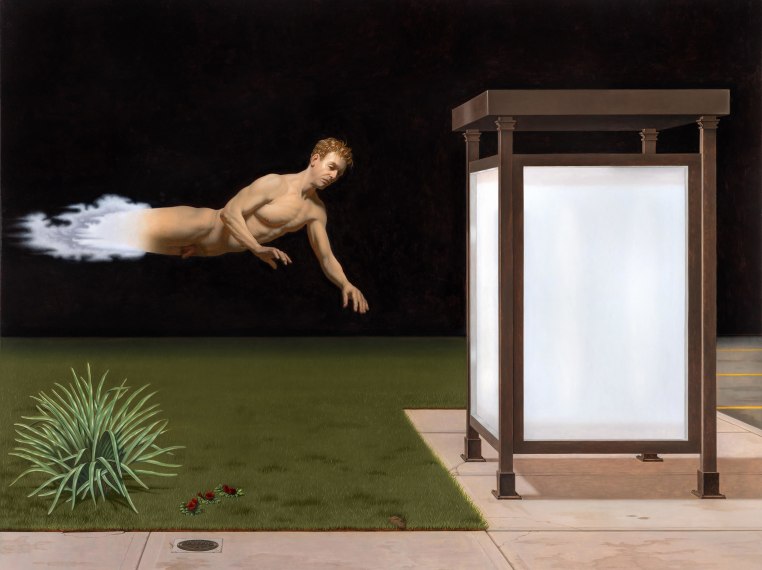
Ortuzar Projects, New York and Marc Selwyn Fine Art, Los Angeles are pleased to present a selection of works by New York–based artist Kurt Kauper (b. 1966, Indianapolis, Indiana) for the 2023 edition of The Art Dealers Association of America’s The Art Show. The paintings and works on paper, which range from 1997 to 2023, demonstrate the artist’s over 25-year commitment to staging historical and imagined figures in portraits that evoke a sense of performativity. Characterized by ambiguity and uncanniness, Kauper’s figures are nonetheless rendered with a hyperrealistic articulation of form; recalling the formal experimentation of Jean-Auguste Dominique Ingres as well as the evocative light and shadows in the work of Hugo van der Goes and Hans Holbein. Perverting the familiarity of cultural figures—some identifiable, such as the late actor Cary Grant or the Obamas, and others more archetypal, such as athletes, opera divas, “men,” and “women”—Kauper’s paintings originate from a place of, in his words, “watching cultural expectations from a desiring but alienated distance.”
The prima donnas in Kauper’s early Diva Fiction paintings are nameless, invented personalities who nonetheless carry themselves with mannered self-possession. Writing in the New York Times, Holland Cotter explains that the divas “offer what divahood customarily offers: an icon of psychic survival and a role model for a personal fulfillment beyond the bounds of the everyday.” The brunette in Diva Fiction #13 (2000), adorned in a floor-length gown and feathered plumage against a red background, is frozen in a beaming grin. Mid-century Hollywood’s leading man evokes a comparable swagger in Cary Grant #1, (2001). Grant leans against a mantle in the nude, and his unabashed, full-frontal exposure realizes the psychosexual fantasies of a private life shrouded in mystery and rumor.
The figures in Man Lying Down #4 (2016) and Woman #4 (2018) are floating against seamless monochromes and therefore stripped of setting. What remains are the signifiers provided by their bodies alone—the clean-cut business attire and horizontal repose of the former and the athletic physique and statuesque comportment of the latter. Neutralizing the conventions of the female nude, the naked figure in Woman #4 is scaled to be larger than life, confronting the viewer with a monumental physicality removed from any narrative context. Kauper thus occludes his authorial intent, leaving the viewer with their own assumptions, perceptions and desires.
Kauper’s newest paintings feature men in hallucinatory scenarios. The closely cropped depictions of male grooming in his Watching Men series envision moments often left out of popular culture, revealing the performativity of gender to not only be for women. Men in the Park (2022) and Fantasy #3: Man Running (2022) are nighttime vignettes in which protagonists perform unexpected actions in airless suburban settings. The works’ uncanniness is heightened by Kauper’s clear and precise articulations of their musculature; the nude figures invoke the deft mobility of athletes. For Fantasy #4: Man Dancing like Gene Kelly Next to a Broken Car (2023), a nude figure replicates one of Kelly’s soaring moves in a street scene, recalling the actor’s routine for the 1944 film Cover Girl. Performing naked next to a broken–down Toyota Prius, Kauper’s “man” exists in a dreamscape of everyday challenges.
Kurt Kauper lives and works in New York City. He received his BFA from Boston University in 1988 and his MFA from UCLA in 1995. Kauper has had solo exhibitions at Marc Selwyn Fine Art, Los Angeles (2022); Almine Rech Gallery, New York (2018); ACME Gallery, Los Angeles (2015); and Deitch Projects, New York (2009). He has been included in numerous institutional exhibitions, including Together in Time: Selections from the Hammer Contemporary Collection, Hammer Museum, Los Angeles (2023); Mixed Signals: Artists Consider Identity in Sports, Cranbrook Art Museum, Bloomfield Hills, Michigan (2009); Cheir Peintre, Centre Pompidou, Musée National D’Art Moderne, Paris (2002); and the Whitney Biennial, Whitney Museum of American Art, New York (2000), among others. His work is included in the collections of The Museum of Modern Art, New York; Whitney Museum of American Art, New York; Museum of Contemporary Art, Los Angeles; Art Institute of Chicago; Hammer Museum, Los Angeles; Oakland Museum of Art; Weatherspoon Museum, Greensboro, North Carolina; and Yale University Art Gallery, New Haven. He is the recipient of grants from the Elizabeth Greenshields Foundation, the Louis Comfort Tiffany Foundation, and the Pollock Krasner Foundation. He is currently a Professor of Art at Queens College, New York.
